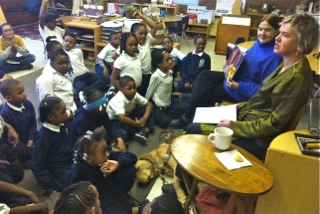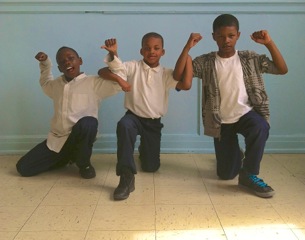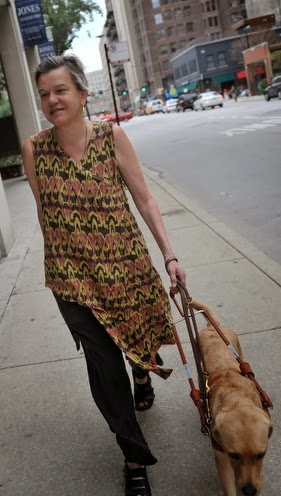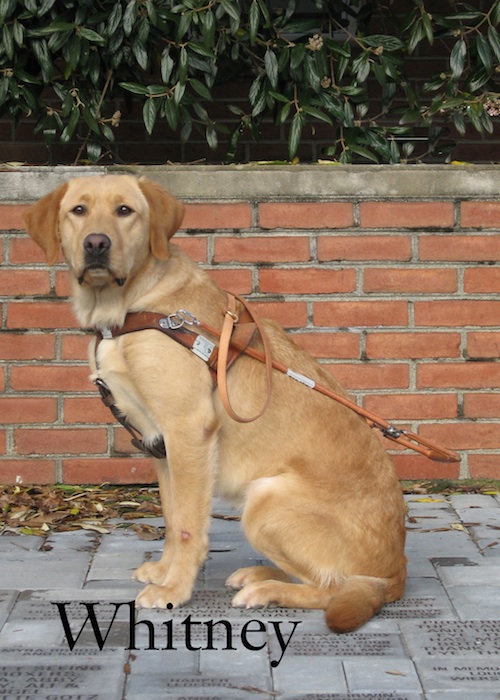Last May my friend Lynn LaPlante Allaway, the principal violist with the Chicago Jazz Philharmonic, came to our apartment to perform a private concert to help me heal from open-heart surgery. Whitney and I tried to thank Lynn for her music therapy by visiting her kids at St. Petronille School, and gee whiz, now I have to thank her again for this guest post about our time together that day. I’m blushing at the glowing account — and reminding myself that she’s a biased reporter. But I’m biased, too, and I’m happy to share Lynn’s post:
The craziest thing happened when I went to meet Beth and Whitney at the train platform here in Mayberry, err…Glen Ellyn. After big hugs all around, we were standing there deciding very important business — coffee first or straight to the school? — when I saw a tall gentlemen walking behind Beth, coming straight at her. I could only see his head, coming closer and closer and….what the hell, is he going to just crash right into Beth? Doesn’t he SEE her standing there with her damn GUIDE DOG? Are you kidding me? Annnd…he did. He just smacked right into her.
I was shocked, Beth was shocked and so was this gentleman, who was also blind and using a white cane instead of a guide dog. Are you kidding me, people? What are the odds of two blind people colliding on the totally empty Glen Ellyn train platform, midday on a Friday? We were the only three people standing there and I looked around to see if we were being punked.
And: they knew each other. Of course they did. They laughed about being part of a blind mafia, but I’m not so sure they were joking. This gentlemen had taken the train to Glen Ellyn to catch a bus to take him to the grocery store. (Note to self: I will never, ever complain again when I get home from Trader Joe’s and realize I forgot cat food and I have to go back and get it.)
We all had a good laugh, and that began a day of coincidences, connections, and little woo-woo moments that I just LOVE. The day felt magical, pure and simple. It was more than just me having the “day off” to play with my friend Beth all afternoon. It was one of those full-moon, all the stars are aligned, everything goes smoothly and beautifully kind of days.
Right–to that point: we got coffee, stopped at The Bookstore to see Beth’s friend Jenny Fischer (all these coincidences between Beth’s childhood friends who now happen to live here, then I moved here, our paths cross, see what I’m talking about?) and got to school.
These kids have been so excited about Beth and Whitney’s visit! Talking about it all week, reading her book, preparing questions ahead of time! And the teachers were so appreciative of Beth and Whitney being there. Honestly, we were feeling the love all freaking afternoon.
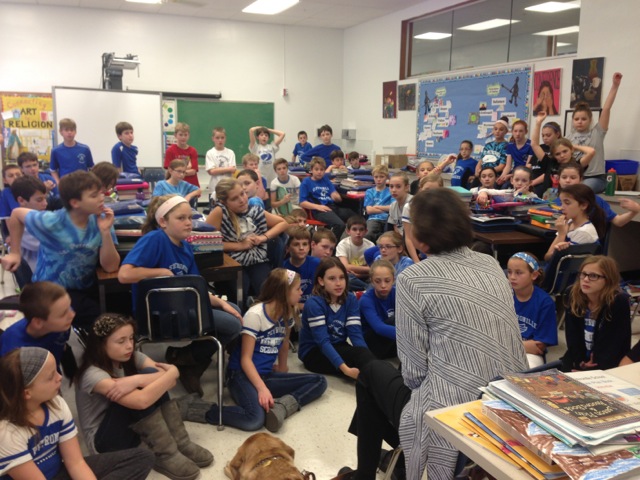
All three classrooms were as rapt as this one.
First class was my son Aidan’s class — all 60 5th graders gathered in the Art Room and sat there, so quiet, so still, so mesmerized. I spend a lot of time in my kids classrooms, volunteering, assisting, whatever. They are lovely children, but trust me when I tell you they do not sit this quietly and engaged for me when I am giving an Art in the Classroom presentation. But that’s Beth for you: always gotta one-up me and show me how it’s really done!
She talked to these students about what it feels like to be blind, about how she lost her sight, about how she does her daily tasks. Beth has this ability to talk *to* these kids rather than *at* them. She assumes they are intelligent, sensitive, thoughtful and can comprehend what she is describing. And she is right: the level was raised that day for those 5th graders.
She asked Aidan to join her in front and call on classmates who had questions. He was so cute and blushed a bit while he did that. I hope he doesn’t read this; he’ll kill me for saying that.
Beth let Whitney off her harness so all 60 kids could get in line and pet her — Whitney looooved this. She is one playful and cute dog, and the kids looooved this as much as Whit did. I heard all about it later from friends with kids in the class.
From there, we went downstairs to visit my daughter Sophie and the third graders. Beth told them that in some ways losing her sight was a relief. It meant the painful, difficult time in the hospital with all the tests and surgeries was over. She also talked about the job she’d had before losing her sight, and how she had considered her boss a friend. But that was before the Americans with Disabilities Act was a law. “I couldn’t see anymore,” she told the kids. “So my boss fired me.”
The most poignant question came during that presentation, when a student circled back after Beth was done talking and asked her if she was sad her “friend” hadn’t let her keep her job after she lost her sight. This was such a gorgeous moment because it showed, crystal clear, how these students were able to feel compassion and empathy for another person’s pain. They saw Beth as she is, her funny personality, her great storytelling, her ease and comfort in front of and surrounded by people. And they understood. They related to the story she told them about her life, they were able to imagine how they themselves would feel if they were in the same position. They understood that people who appear to be “different” from them are not different at all.
What an education Beth provided that afternoon! I loved watching the kids’ faces watching Beth and Whitney. Sophie also got to lord over her classmates and call on them for the Q&A section. My little budding Napoleon, drunk on her own power, as she decided who got to ask questions. Hilarious.
And finally, off to first grade. I’m with these kids A LOT and when we walked in, I couldn’t believe it. No one was squirming or wiggling. None of these kids were talking or doing gross things involving their fingers and noses. They were spellbound from the first moment. Beth changed her talk again for this age-group. She is really ridiculously good at this: three different talks for three different age groups, la de da, no biggie.
Whitney stretched out here in this classroom and took a little snooze. Our son, August, got up to call on kids. I’d explained ahead of time that he couldn’t just call on boys. “You HAVE to call on girls, too.” He apparently was so scared of catching cooties from calling on a girl. At one point, Beth had to ask, “August, are there any girls in your class?” Adorable.
Beth ended each presentation by showing the kids how Whitney can show Beth where the door in the classroom is located and lead her to it so she can get out. And with that, and lots of applause and thank-yous from the first-graders, we left. But for Beth and me, the fun was just beginning.
We shopped at Marcel’s, her high school friend Jill Foucré’s sublime cooking store in downtown Glen Ellyn, and then Jill and Jenny from The Bookstore (they are sisters, see above about connections and coincidences) and Beth and I met for happy hour at the sushi bar down the street. We talked about books, being working moms, family. We talked and talked and laughed and laughed. It was heavenly.
I took Whitney and Beth back to the train station, and after scanning the platform to make sure there were no more blind people waiting to ambush her (for real, I still can’t believe that happened?) I waited with them until their train to Chicago arrived and watched them get on board. That was a solid six hours of bliss. Come back, Beth!!
00
